 W
WDanish cuisine originated from the peasant population's own local produce and was enhanced by cooking techniques developed in the late 19th century and the wider availability of goods during and after the Industrial Revolution. Open sandwiches, known as smørrebrød, which in their basic form are the usual fare for lunch, can be considered a national speciality when prepared and decorated with a variety of fine ingredients. Hot meals are typically prepared with meat or fish. Substantial meat and fish dishes includes flæskesteg and kogt torsk with mustard sauce and trimmings. Ground meats became widespread during the industrial revolution and traditional dishes that are still popular includes frikadeller, karbonader and medisterpølse. Denmark is known for its Carlsberg and Tuborg beers and for its akvavit and bitters, but amongst the Danes themselves imported wine has gained steadily in popularity since the 1960s.
 W
WImportant parts of Faroese cuisine are lamb and also fish owing to proximity to the sea. Traditional foods from the Faroe Islands include skerpikjøt, seafood, whale meat, blubber, garnatálg, Faroese puffins, potatoes, and few fresh vegetables.
 W
WGreenlandic cuisine is traditionally based on meat from marine mammals, game, birds, and fish, and normally contains high levels of protein. Since colonization and the arrival of international trade, the cuisine has been increasingly influenced by Danish, British, American and Canadian cuisine. During the summer when the weather is milder, meals are often eaten outdoors.
 W
WÆbleflæsk is a traditional Danish dish consisting of cured or salted pork belly, fried with apples, thyme and sugar. Chopped onion is often fried with the apples.
 W
WÆbleskiver are Danish snacks that are spherical in shape. The name literally means "apple slices" in Danish, although apples are not usually an ingredient in present-day versions. The crust is similar in texture to European pancakes, but with a light and fluffy innard like a Yorkshire pudding. The English language spelling is usually aebleskiver or ebleskiver.
 W
WAlexandertorte, also known as Alexander Torte or Aleksander Torte, is a dessert that was conceived to commemorate a visit of Tsar Alexander III in Riga, today's capital of Latvia.
 W
WArnbitter is a Danish bitters produced and distributed by the Copenhagen based company Just Drinks, originally produced and developed in Aarhus. The drink can be traced back to the 1950s and is sold under the slogan "Hverken ny, trendy eller importeret". The recipe is secret but includes ginger, cloves, saffron and licorice root. Arnbitter is mixed in large 2,500 litre copper tanks where it is stored for 3 months before bottling.
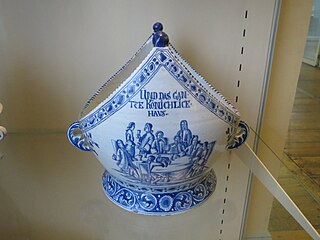 W
WA bishop-bowl is a punch bowl made of faience and shaped in the form of a mitre that was popular in Denmark and Schleswig-Holstein in the eighteenth end nineteenth centuries. The alcoholic drink served from the bowl was known as "bishop".
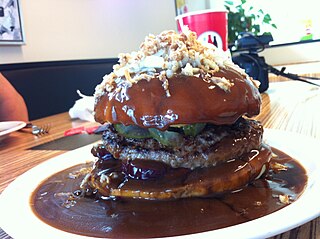 W
WA Bøfsandwich, is the classic Danish take on a hamburger. It contains the hamburger elements of a cooked ground beef patty placed inside a sliced bread roll.
 W
WBrændende kærlighed is a traditional Danish dish consisting of mashed potatoes topped with bacon and onions, both fried. The mashed potatoes might also be topped with parsley, leek, or grated nutmeg.
 W
WIn classical French cuisine, a brown sauce is generally a sauce with a meat stock base, thickened by reduction and sometimes the addition of a browned roux, similar in some ways to but more involved than a gravy. The classic mother sauce example is espagnole sauce as well as its derivative demi-glace, though other varieties exist.
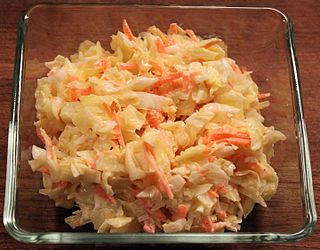 W
WColeslaw, also known as cole slaw, New England salad, or simply slaw, is a side dish consisting primarily of finely shredded raw cabbage with a salad dressing or condiment, commonly either vinaigrette or mayonnaise. Coleslaw prepared with vinaigrette may benefit from the long lifespan granted by pickling.
 W
WCookie butter is a food paste made primarily from speculoos cookie crumbs, fat, flour, and sugar. The ingredients are mixed until it becomes spreadable on a sandwich. In countries like Belgium, the Netherlands, and France, it is a common alternative to nut butter and chocolate spreads. The most common brand name is Lotus Bakeries.
 W
WDyrlægens natmad is the Danish name for a smørrebrød, also known as an open faced sandwich, made with a particular selection of toppings. The name of this snack originated in the 1920s in Oskar Davidsen's sandwich bread restaurant in Copenhagen. According to food historian Nina Bauer the famous sandwich is named after one of the restaurant's regulars, a distinguished veterinarian named Sigurd Kejlgaard, who was employed to look after the horses in the royal stables and the contemporary Circus Miehe.
 W
WEels are elongated fish, ranging in length from 5 centimetres (2.0 in) to 4 metres (13 ft). Adults range in weight from 30 grams to over 25 kilograms. They possess no pelvic fins, and many species also lack pectoral fins. The dorsal and anal fins are fused with the caudal or tail fin, forming a single ribbon running along much of the length of the animal. Most eels live in the shallow waters of the ocean and burrow into sand, mud, or amongst rocks. A majority of eel species are nocturnal and thus are rarely seen. Sometimes, they are seen living together in holes, or "eel pits". Some species of eels live in deeper water on the continental shelves and over the slopes deep as 4,000 metres (13,000 ft). Only members of the family Anguillidae regularly inhabit fresh water, but they too return to the sea to breed.
 W
WFilmjölk, also known as fil, is a traditional fermented milk product from Sweden, and a common dairy product within the Nordic countries. It is made by fermenting cow's milk with a variety of bacteria from the species Lactococcus lactis and Leuconostoc mesenteroides. The bacteria metabolize lactose, the sugar naturally found in milk, into lactic acid which means people who are lactose intolerant can tolerate it better than other dairy products. The acid gives filmjölk a sour taste and causes proteins in the milk, mainly casein, to coagulate, thus thickening the final product. The bacteria also produce a limited amount of diacetyl, a compound with a buttery flavor, which gives filmjölk its characteristic taste.
 W
WA fishcake is a culinary dish consisting of filleted fish or other seafood minced or ground, mixed with a starchy ingredient, and fried until golden.
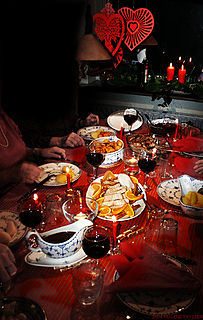 W
WFlæskesteg, ['flɛːskə.stɐ̯j] the Danish version of roast pork, is considered to be one of Denmark's principal national dishes. Always prepared with crackling, it is also a favourite for the Danish Christmas dinner served as the evening meal on 24 December or Christmas Eve.
 W
WFrikadelle are flat, pan-fried meatballs of minced meat, often likened to the Danish version of meatballs. The origin of the dish is unknown. The term "frikadelle" is German but the dish is associated with Danish, Scandinavian and Polish cuisines as well as German cuisine. It is considered a national dish in Denmark. They are one of the most popular meals in Poland, where they are known as "kotlety mielone". In Norway, the dish is known as Kjøttkaker.
 W
WGammel Dansk is a bitters produced by Arcus-Gruppen in Oslo, Norway, originally developed and produced by Danish Distillers in Denmark. Traditionally it is drunk by Danes at certain festive occasions, often in connection with breakfast meals, brunch or at wedding anniversaries and birthday celebrations. The name "Gammel Dansk" translates directly from Danish as "Old Danish".
 W
WGravlax or graved salmon is a Nordic dish consisting of salmon that is cured using a mix of salt and sugar, and either dill or sprucetwigs placed on top, and may occasionally be cold-smoked afterwards. Gravlax is usually served as an appetizer, sliced thinly and accompanied by hovmästarsås, a dill and mustard sauce, either on bread or with boiled potatoes.
 W
WJødekager, also known as Joedekager , is a popular cookie of Danish Jewish origin. The cookie originated in the Danish Jewish community in Denmark starting in the 1700s, and remain popular to this day.
 W
WJulebord is a Scandinavian feast or banquet during the Christmas season where traditional Christmas food and alcoholic beverages are served often in the form of a buffet. Originally, the julebord belonged to Christmas itself, i.e. the period from Christmas Day and onwards. Today julebord is often organized by employers or organizations for the employees or members. Scandinavian feast or banquet during the Christmas season where traditional Christmas food and alcoholic beverages are served often in the form of a buffet. Originally, the julebord belonged to Christmas itself, i.e. the period from Christmas Day and onwards. Today julebord is often organized by employers or organizations for the employees or members.
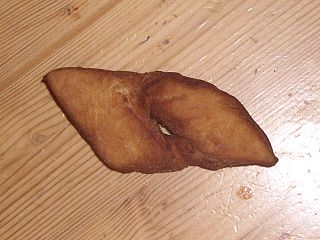 W
WKlenät, kleinur, klena, klejne, kleina, kleyna, and fattigmann are all names for Angel wings, a fried pastry common in the Nordic countries as well as the rest of Europe and the United States. In nearby countries and Eastern European countries. The name is related to klen, the Swedish term for "slender", but is originally of Low German origin, which may indicate that the pastry was originally German. It is made from flattened dough cut into small trapezoids. A slit is cut in the middle and then one or both ends pulled through the slit to form a "knot". The kleina is then deep-fried in oil or another kind of fat. Subsequently can be sprinkled with powdered sugar and cinnamon.
 W
WLabskaus is a culinary speciality from northern Germany and in particular from the cities of Bremen, Hamburg, and Lübeck. The main ingredients are salted meat or corned beef, potatoes, and onion. Some recipes put beetroot, pickled gherkin, or even herring into it, while others have these ingredients as side orders.
 W
WLingonberry jam is a staple of Northern European cuisine and otherwise highly popular in Central and Eastern Europe. Lingonberries grow on a short evergreen shrub in the Arctic tundra throughout the Northern Hemisphere from Eurasia to North America.
 W
WLiver pâté is a pâté and meat spread popular in Northern and Eastern Europe. Made from finely or coarsely ground pork liver and lard, it is similar to certain types of French and Belgian pâtés.
 W
WMashed potato, mashed potatoes or mashed taters, colloquially known as mash, is a dish made by mashing boiled potatoes, usually with added milk, butter, salt and pepper. It is generally served as a side dish to meat or vegetables. When the potatoes are only roughly mashed, they are sometimes called smashed potatoes. Dehydrated instant mashed potatoes and frozen mashed potatoes are available. Mashed potatoes are an ingredient in other dishes, such as dumplings and gnocchi.
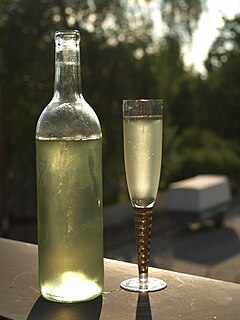 W
WMead is an alcoholic beverage created by fermenting honey with water, sometimes with various fruits, spices, grains, or hops. The alcoholic content ranges from about 3.5% ABV to more than 18%. The defining characteristic of mead is that the majority of the beverage's fermentable sugar is derived from honey. It may be still, carbonated, or naturally sparkling; dry, semi-sweet, or sweet.
 W
WMedisterpølse, medisterkorv or simply medister, is a Scandinavian specialty food consisting of a thick, spiced sausage made of minced pork and suet, stuffed into a casing. It is a slightly sweet-tasting sausage and the finely-ground meat is seasoned with chopped onion, allspice, cloves, salt and pepper. It is a traditional dinner sausage in Danish cuisine.
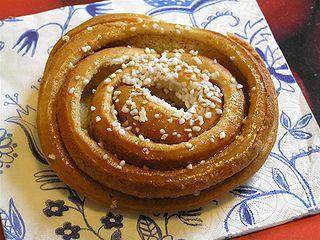 W
WNib sugar is a product of refined white sugar. The sugar is very coarse, hard, opaque white, and does not melt at temperatures typically used for baking. The product usually is made by crushing blocks of white sugar, then sifting to obtain fragments of a given diameter. The sugar may also be made in an extrusion process.
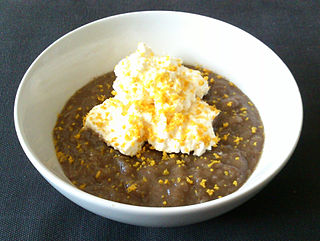 W
WØllebrød is a traditional Danish dish. It is a porridge made of rugbrød and beer, typically hvidtøl, and is considered a thrifty dish.
 W
WAn open sandwich, also known as an open-face/open-faced sandwich, bread baser, bread platter, half-widge or tartine, consists of a slice of bread or toast with one or more food items on top.
 W
WPålægschokolade are thin slices of chocolate that are used as a topping on bread, such as rugbrød or white bread, similar to how chocolate spread is used in many countries. It is common in Denmark.
 W
WPfeffernüsse are small spice cookies, popular as a holiday treat with Germans, and ethnic Mennonites in North America. Similar cookies are made in Denmark, and The Netherlands, as well. They are called Pfeffernüsse in German, pepernoten in Dutch, päpanät in Plautdietsch, pfeffernusse or peppernuts in English, and pebernødder in Danish.
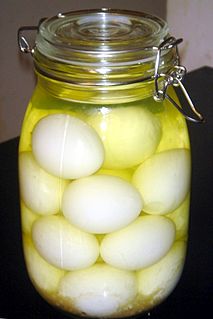 W
WPickled eggs are typically hard boiled eggs that are cured in vinegar or brine. As with many foods, this was originally a way to preserve the food so that it could be eaten months later. Pickled eggs have since become a favourite among many as a snack or hors d'œuvre popular in pubs, bars and taverns, and around the world in places where beer is served.
 W
WRød pølse is a type of brightly red, boiled pork sausage very common in Denmark. Since hot dog stands are ubiquitous in Denmark, some people regard røde pølser as one of the national dishes. They are made of the Vienna type and the skin is colored with a traditional red dye (carmine).
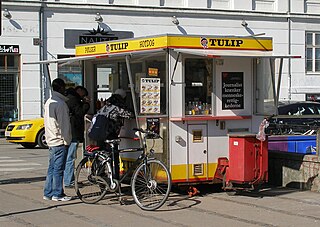 W
WPølsevogn(e) are hot dog stands that sell Danish style hot dogs, such as rød pølse, and sausages as street food. Today, some are mobile, and some are, despite their names, permanent structures. They are equipped with a small kitchen, boilers, an external desk and room for a pølsemand (sausage-man) preparing and selling hot dogs to passing customers. Pølsevogne are numerous across Denmark and are popular among Danes and tourists alike.
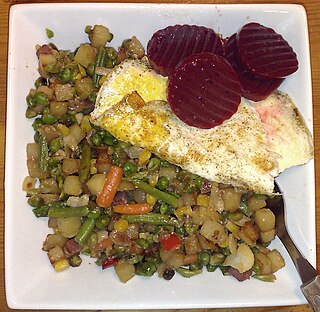 W
WPytt i panna, also pytt i panne, pytt i panne (Norwegian), pyttipannu (Finnish), is a culinary dish consisting of chopped meat, potatoes, and onions fried, similar to a hash. The term is Swedish for "small pieces in pan". It is a popular dish in Sweden, Norway and Finland, and in Denmark, where it bears the name biksemad, literally meaning "mixed food".
 W
WRémoulade is a European cold sauce based on mayonnaise. Although similar to tartar sauce, it is often more yellowish, sometimes flavored with curry, and sometimes contains chopped pickles or piccalilli. It can also contain horseradish, paprika, anchovies, capers and a host of other items.
 W
WRoast beef is a traditional dish of beef that is roasted. Essentially prepared as a main meal, the leftovers are often used in sandwiches and sometimes are used to make hash. In the United Kingdom, United States, Canada, Ireland, South Africa, New Zealand, and Australia, roast beef is one of the meats traditionally served at Sunday lunch or dinner, although it is also often served as a cold cut in delicatessen stores, usually in sandwiches. A traditional side dish to roast beef is Yorkshire pudding.
 W
WRugbrød is a very common form of rye bread from Denmark.
 W
WRullepølse, also spelled rullepoelse or rullepolse, is a traditional Danish cold cut. A piece of pork belly—variants use beef flank or lamb—is flattened out and is spread with herbs and seasoning, chopped onions, and in some variants, parsley. It is then rolled up and placed in a brine for a number of days, before being placed in a special press, cooled, and sliced thinly. It is often use on rugbrød to make the traditional Danish open-faced sandwich, smørrebrød, usually garnished with a thick slice of sky and rings of raw onion.
 W
WRumtopf, which literally means rum pot, is an Austrian, German and Danish dessert of mixed fruit and alcohol traditionally eaten around Christmas. It is also made in northern Italy, especially in the valleys of Trentino, where it became traditional in Valsugana.
 W
WSmørrebrød is a traditional Danish-Norwegian open-faced sandwich that usually consists of a piece of buttered rye bread, a dense, dark brown bread, topped with commercial or homemade cold cuts, pieces of meat or fish, cheese or spreads, and garnishes.
 W
WSnaps is a Danish and Swedish word for a small shot of a strong alcoholic beverage taken during the course of a meal. A ritual that is associated with drinking snaps is a tradition in Scandinavia, especially in Denmark and Sweden, where it is very common to drink snaps at holidays such as Midsummer, Christmas and Easter. This ritual has been described by one author as follows:A group of people are clustered around a table for a typical lunch that will include several courses and a clear, fiery drink. The host pours the ice-cold liquid into frosty, conical glasses with long stems. He raises his glass, at which point the diners turn to one another and make eye contact, making certain not to leave anyone out. "Skål!" calls out the host, and everyone takes a sip. Again there is eye contact, and then the glasses are set on the table, not to be lifted again until the host raises his. The liquid is aquavit. The ritual is virtually the same throughout Scandinavia.
 W
WSol over Gudhjem, literally "sun over Gudhjem", is a Danish dish, an open sandwich with rugbrød, smoked herring, chives and a raw egg yolk on top. The island of Bornholm, where Gudhjem is situated, is known for its smoking houses (røgerier).
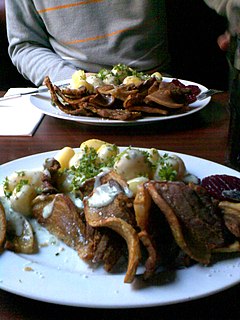 W
WStegt flæsk is a dish from Denmark consisting of fried pork belly and generally served with potatoes and parsley sauce (persillesovs). The dish is sometimes translated as 'pork strips' or 'crisp fried pork slices'. The pork belly or "breast" cut of a pig is used for stegt flæsk and the strips are cut about a 1/4 inch thick.
 W
WTilslørte bondepiker is a traditional Scandinavian dessert. The dessert is available in a number of different variations. It is typically served in transparent in glass glass or bowls.
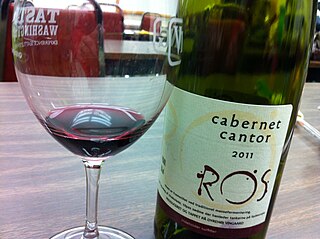 W
WDanish wine is wine made in Denmark.
 W
WYmer is a Danish soured milk product which has been known since 1930. It is made by fermenting whole milk with the bacterial culture Lactococcus lactis. When producing fermented milk products such as yogurt, ymer, filmjölk, skyr, qvark and A-38, and also when producing cheese, one can add lactic acid bacteria which convert milk sugar in the milk into lactic acid and other substances. Acidity makes the milk thicker, gives it a tart flavor, and increases the shelf life by several days.